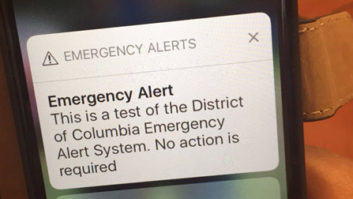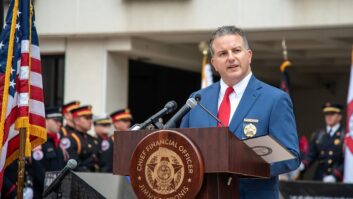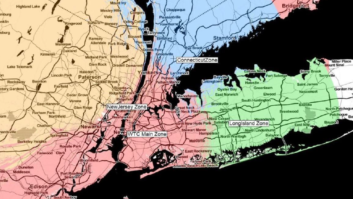DHS alerts from NWR
Nov 1, 2004 12:00 PM
On June 17, 2004, the U.S. Department of Homeland Security (DHS) signed an agreement with NOAA/NWS addressing the transmission of DHS-originated emergency messages over All-Hazards NOAA Weather Radio (NWR).
If the DHS becomes aware of a threat in a particular state or area of the country, after coordination with authorities in each involved state, the DHS will issue an alert to all NWS offices via a link in the Washington, DC, area. NWS offices with NWR coverage areas affected by the threat will broadcast the message on NWR, using the DHS-requested EAS/SAME Event Code. Currently, the alert will not be relayed in text form on NOAA Weather Wire Service (NWWS), EMWIN or any other NWS system.
Although many broadcasters have upgraded their EAS units to the new EAS Event Codes released in 2002, the second step is that the EAS units must be programmed to react to the new codes. If broadcasters want to relay these DHS alerts, they will need to know the Originator Code and Event Codes to program into their EAS unit filters. In reviewing NWS documents NWSI 10-1710 and NWSI 10-518, as well as information provided by Herb White, dissemination services manager at NWS headquarters, the following are the recommendations we felt appropriate at this time.
The Originator Code on all DHS alerts will be CIV (Civil Authorities). Even though the alerts are first broadcast on NWR, they are originated by civil authorities and thus will not carry the WXR (National Weather Service) Originator Code. These non-weather alerts will use the CIV Originator Code.
One of three event codes will normally be used. CEM (Civil Emergency Message) or CDW (Civil Danger Warning) will be used to activate the alerts. ADR (Administrative Message) will be used to terminate the alerts. To be on the safe side, White advises stations to also program the following codes for possible DHS use: EVI, HMW, RHW, SPW, FRW, LAE and NUW. NOAA has requested that the DHS use only the CEM code until the broadcast community adds the other codes into their EAS units. Broadcasters should program these new codes into their EAS unit filters as soon as possible.
In addition to the DHS alerts, a separate agreement between NOAA and the FEMA National Warning Center (NWC) exists for NWR to transmit warnings of nuclear attack as well as other non-weather alerts. Nuclear attack would use code CDW, and the other non-weather alerts could use any of the additional codes that White recommends adding. Using the guidelines above regarding programming for DHS alerts should then cover stations for NWC alerts as well. The NWC alerts are separate from any EAN messages issued by the White House.
Local alerting
The NWS is taking the new All-Hazards Radio moniker to heart, and has made changes recently to make NWR more available to local civil authorities. As of June 30, 2004, all the new EAS Event codes were approved for use on NWR. On Sept. 8, 2004, NWS offices began using the new EAS-equivalent Product Codes in text messaging as well (via NWWS, EMWIN).
NWS has also published a helpful document, NWS Instruction 10-518, which aids local authorities in establishing a relationship with their local NWS Office for the purpose of sending local emergency alerts. Section 5 of the document, Civil Emergency Message, addresses local alerting. It deals with developing procedures, issuance criteria and sample scripts. Appendix C of this document is a landmark. Someone has finally defined the new specific EAS Event Codes. The definitions in Appendix C will be used as a guide for federal authorities in issuing alerts, and they can be useful to local authorities as well. State and local EAS plans should be updated at this time to not only include the relay of DHS alerts, but also to incorporate these new EAS Event Code definitions. This document is available at
www.nws.noaa.gov/directives/010/pd01005018c.pdf.
Looking to the future, NWS is currently working on a system called Haz Collect, which it expects to begin deploying in mid-2005. This would be a secure, centralized interface, with backups, that would be used to collect non-weather hazard messages from local, state and federal authorities and get them into the NWR system. NWS is really going the extra mile to work with local authorities, and it’s great to see.
Contact Herb White at [email protected].
Gary Timm
broadcast engineer, Journal Broadcast Group
broadcast chairman, Wisconsin EAS Committee
Milwaukee
Support to reduce to 5kHz
Without regard to AM IBOC operation (which may or may not be on the horizon for some or all of our numerous AM stations), we at Crawford Broadcasting Company have been experimenting with reduced audio bandwidth for some time now. Our experience mirrors that reported by Mr. Littlejohn. Except for what the very few listeners who use �wideband� receivers may observe, there is no observable penalty for reducing bandwidth to 5 or 6kHz. The gains are reduced interference, improved spectrum efficiency, loudness and clarity. As such, we have elected to join Clear Channel in reducing audio bandwidth on our talk format stations.
Cris Alexander
director of engineering
Crawford Broadcasting Company
Appealing the 5kHz limit
Clear Channel has its own agenda when pushing a 5kHz bandwidth. We who are required to operate a stereo signal because we use the expanded band would be forced to go IBOC or sound like crap if limited to 5kHz. And we have many listeners who hear our stereo signal with receivers that hit the full 10kHz.
Steve Soboroff
owner, 1630 KCJJ
Iowa City, IA
When I read that Clear Channel will reduce the AM audio bandwidth of all its stations, and that Jeff Littlejohn proposes the change to the NRSC for all AMs, I know that more investigation by our engineering community is needed. Why does this degradation appear to be a smokescreen for IBOC quality issues? In my opinion, by degrading analog AM to 5kHz mono, it will make IBOC seem like a huge improvement, whereas analog stereo out to 10.2kHz is equal to or better sounding than IBOC in some instances.
Are they perhaps saying: “Let’s make analog AM sound so bad now that IBOC will seem like a good investment.”? Is this why Clear Channel just this week killed the spectacular stereo music from KABL � to downgrade its decent-sounding stations to telephone audio in advance of IBOC?
To those who say there are no decent bandwidth AM radios, look no farther than your local Wal-Mart and Dollar General stores. They both have a portable $5 AM/FM radio with wide AM bandwidth beyond 5kHz. There is also a �one-chip� AM tuner that typically uses a �barn door� ceramic filter and even Ford has an AMAX (7.5kHz) bandwidth radio in its 2005 models.
I just don’t buy this AM analog audio downgrade as an engineering improvement. Clear Channel can do what it wants to with the audio quality of its stations, but its business decisions should not be mandated to the rest of the AM broadcasters via an NRSC mandate.
John Pavlica
Toledo, OH
Jeff Littlejohn’s contention that AM receivers have less than 5kHz frequency response ignores the multitude of people listening on AM stereo radios, AM wideband radios, and older AM radios that had great frequency response. Clear Channel’s motives are suspect and should be taken with �a box of salt!�
David Creel
chief engineer
Far East Broadcasting Company
Saipan
Bear with my oversimplified math here but isn’t having 50kW signals running IBOC sidebands at night the equivalent of having a 5kW jammer on adjacent frequencies? How will any signal on an adjacent frequency be able to be heard (or, better, why would anyone want to listen to it) over the noise that will be generated?
By way of example, my station’s 54W night signal covers its target area well while it does little to interfere with anyone else’s reception save anyone trying to DX 660kHz in our immediate area. In fact, there would be little to hear most of the time. And, in fact, it wouldn’t have been licensed if it would put any kind of interfering signal into the dominant station’s protected area. However, there are closer class As on 650 and 670 that sometimes put in �peeling the paint off the wall� signals into our service area. If these stations are running IBOC sidebands � and let’s call them what they are: they’re not carriers, they’re sidebands on the already existing carrier just like the analog sidebands that create �monkey chatter� now � how will my 54W signal be able to compete with 5kW jammers right on my frequency?
On the other hand, how will my station’s effectively 5.4W digital signal (sidebands off to either side of 660) be able to compete with the 50kW analog carriers booming in on 650 and 670?
If this argument needs any more fuel, the recent objective to reduce the analog bandwidth announced by Jeff Littlejohn and Clear Channel just proves my point. If the present 10kHz analog sidebands can produce interference � and we all know they do but only on a part time basis because they are analog � how much worse will 100 percent duty cycle digital sidebands produce similar interference or worse and won’t the character of that interference and high average power of that new interference render more adjacent signals unusable? To quote Jeff’s own statement, albeit out of context, “Whether it’s analog or digital doesn’t matter.”
I still believe IBOC on AM is a solution looking for a problem. It is not optimum usage of this band of frequencies and its characteristics. A new band should have been (and should still be) chosen. Then those who wished to ride the old band down to the end could have done so in peace. Either way, the consumer needs a new radio, but with a new band, old radios wouldn’t have been made obsolete until there was nobody transmitting anything to hear rather than having signals fighting for their lives against what amounts to legalized jamming. Who knows how long the old band would hang on if the programming is worth listening to and can indeed be heard?
The FCC says it wants to bolster �local� radio. Seems like the deck is stacked against local radio (again). It was the class A operators who didn’t want to move to a new band and give up skywave service they can’t even sell that in part gave us this IBOCcle we now face, which will effectively jam out local service in many areas. As I’ve said before, this has nothing to do with audio quality to the consumer; it’s a spectrum grab plain and simple.
It’s also short-sighted. With today’s technology (not tomorrow’s pie-BOC in the sky) those operators who objected to losing coverage area could have been compensated in a new band with additional allocations which they could have programmed centrally at little, if any, additional recurring cost.
I don’t expect the steamroller will be stopped, but if I had my druthers, I would rather not be able to say, �I told you so.�
As far as Littlejohn’s proposal is concerned, I am opposed to it. Clear Channel can do what it wants, but where does the company get off proposing that all should be made to do the same? While I agree with the idea that, mathematically, limiting audio bandwidth to 5kHz would make the AM signal fit the channel allocations, it really isn’t necessary for one thing (except to permit IBOC sidebands), and for another the missing octave of audio really will make a difference even on narrow bandwidth radios. I happen to think that difference will serve to make AM radio sound even more inferior to most ears.
Mike Shane
operations manager, KCRO-AM 660
Omaha, NE
Digital pioneer
I remember the Technics SV-P-100 digital recorder featured in the August Sign Off. I was lent one of these machines with a pre-recorded tape of Earl Klugh (Finger Paintings) and played it on the then KLSI 93.3 on Oct. 8, 1982, making us the first station in the Kansas City market to play anything from a digital source on the air. KLSI also played the very first CD on the air a few months later on Feb. 11, 1983.
Ben Weiss, CPBE
engineering director
KMXV and KSRC/Infinity Broadcasting
Kansas City
How long, big brother?
I read Chriss’ editorial [Shades of Big Brother] in the August 2004 issue with some concern.
Perhaps there are additional rules proposed that also limit the length of time that a broadcaster is required to maintain these copies of the programming. I could see one year as a possibility, which results in stacks of boxes of slow-speed tapes for the radio broadcasters (or CDs, etc.), but how about the television broadcasters? One would think such a rule would affect them as well, and recording video for long-term storage is a bit more cumbersome. And what if the save duration wasn’t given; does the broadcaster then have to look at saving its radio and TV programming �forever�?
And what if a broadcaster decided to junk the recordings from so many years ago, and someone decided to request an older log? What’s the mechanism to determine if the station willfully acted against the law?
This really sounds like a rule that has no reason for being.
Dave Felt
Pasadena, CA
The new low-fi
The MP3 explosion is going to create a whole generation of music lovers who think good sound is audio run through a blender and stuffed into a RAM chip or replayed through a $100 home theater system with a 5.25″ speaker in a ported plastic box. Home theater is apparently exempt from IHF standards.
Don Imus loves his MP3 player and wears two hearing aids. I’ve heard better audio in the AM window on the 75m ham band. Seems to me we are going backwards and a lot of money will be wasted on transmission modes that are �better than FM� for just the few who know the difference. By the way, I am not a silver-speaker-wire, $200-patch-cord audio nut, but I have heard MP3 played on a good system and it don’t impress!
Charles DiLuglio
legal counsel
Rhode Island
Want to share an opinion?
Send it to [email protected]
comments?
[email protected]












